My current digital camera is a Fujifilm X-T20 and when I am out shooting, I can change the simulated ISO setting as high as 12,800 in standard mode and 51,200 in “extended” mode meaning that no matter how slow of a lens I mount to it, I can shoot the camera hand held in the lowest of interior night.
For film photographer, they didn’t have it quite so easy, but with films like Kodak’s Tmax P3200, they could push their films into some pretty low, low light territory.
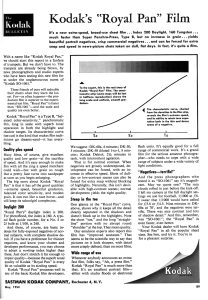
But it wasn’t always that way. Kodak’s Panatomic-X film from 1933 was rated at ASA 25 and Ilford’s original FP film from 1934 had an ASA rating of 28. Back then, a fast black and white film was Kodak Super-XX at ASA 200 and Ilford HP at 160.
As the 1940 and 50s went on, films incrementally got faster. ASA 200 speed films were now the norm and even some 400 speed films hit the market, and by the mid 1950s if you needed ultra high speed films, you had two options, AGFA Isopan Record, which was rated at ASA 640 and Ilford HPS which was ASA 800.
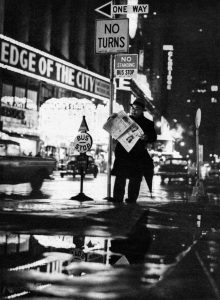
In 1957, Kodak upped the ante quite a bit more with a new film which made it’s debut a year earlier in private use under the code name SO 1177. That film was Kodak Royal-X Pan, which when it was released, was rated at an astounding ASA 1600.
Fun Fact: In his book, “Making Kodak Film” 2nd Edition, Robert Shanebrook says, “Kodak dubbed the film Royal-X because when the coronation of Queen Elizabeth II was to be held in Westminster Abbey in June 1953, flash photography was to be forbidden during the ceremony. Kodak film designers were given the assignment to make a fast film to facilitate available light photography. Their emulsion was coated on paper to get an extra speed boost. The next year a new film using a similar emulsion, Kodak Royal Pan Film, was introduced.”
This week’s Keppler’s Vault takes a look at three articles, the first from the June 1957 issue of Popular Photography and the other two from the March 1959 and February 1961 issues of Modern Photography introducing the world to this extremely fast film.
What really interested me was how quickly the people testing the film were willing to see how far they could push the film.
On the first page of the first article from June 1957, Bob Schwalberg from Popular Photography declares usable results can be had at ASA 8000 and even includes a sample shot at ASA 12,800. Numbers like this must have seemed fantastical to photographers in an era where ASA 640 was still considered fast.
The second article, from the February 1961 issue of Modern Photography suggests that not many people may have heard of Royal Pan because it is only available in 100 ft bulks rolls under the name “Royal-X Recording Film” which I find odd, but at the low, low price of $11 for the bulk roll, that comes out to roughly eighteen 36 exposure rolls of film at a per roll cost of 61 cents each, which when adjusted for inflation compares to $5.28 a roll today.
The final article, from March 1959 is actually a review of what was then new AGFA Isopan Record, and compares it to Kodak Royal-X. Isopan Record was Germany’s fastest film upon it’s released, being conservatively rated at ASA 640, with optimal results in the range of ASA 1600 and 2000.
As with any black and white film comparison, declaring a winner isn’t as easy as shooting a roll of each, developing it, and looking at the negatives as there’s a huge amount of variables to consider, such as the accuracy of your meter and which developer you use and for how long it’s developed. The results also depend on your expectations for the film. Are you interested in lots of grain, or less grain, high contrast or low contrast, shadow detail or no shadow detail.
While John Wolbarst doesn’t declare a definitive winner, to my eyes, looking at the results on the third page and reading his analysis of development variables, I think that had I been a photographer back when these two films were available, I would have preferred the Kodak Royal-X.
As the years went by, higher speed films became more and more common. Improvements to newer films reduced grain, increased contrast, and simplified development and that meant many older films had to be discontinued. Kodak Royal-X was discontinued around 1987 and any examples that still can be found today are at least three decades expired.

While shooting expired film is very common today, from experience I can say that the slower speed the film, the more likely it is to hold up so faster films like Royal-X don’t seem to hold up as well. The only modern review I could find where someone shot it, was this review from photo-utopia by Mark Antony Smith in February 2008.
Smith’s sample was a roll of 120 roll film expired in 1976 that he rated as a 100 speed film to get the results he did. Looking at his samples, I’d say his speed rating was spot on. I was impressed with the level of shadow detail still left in the film. Grain was still prominent, but didn’t distract from the details in the image.
I think the image benefited from the larger size of 120 film as opposed to what he might have achieved had he been using 35mm film from the same era.
Beyond Smith’s review, I found no other examples of Royal-X Pan shot by people in the 12 years since that article was written, and there’s probably a reason for that. With the exception of a handful of examples on eBay, acquiring viable Royal-X today would likely be very difficult.
If, by chance, you happen to have some, and want to give it a shot, I’d say that ASA 100 should be your starting point, but you might need to go down to 50 or even 25. If your film was created after January 1978, you might find the following technical chart helpful as it gives some helpful development tips. Finally, if you do get some good images, please let me know in the comments and perhaps I can update this article with more recent samples.
All scans used with permission by Marc Bergman, 2020.

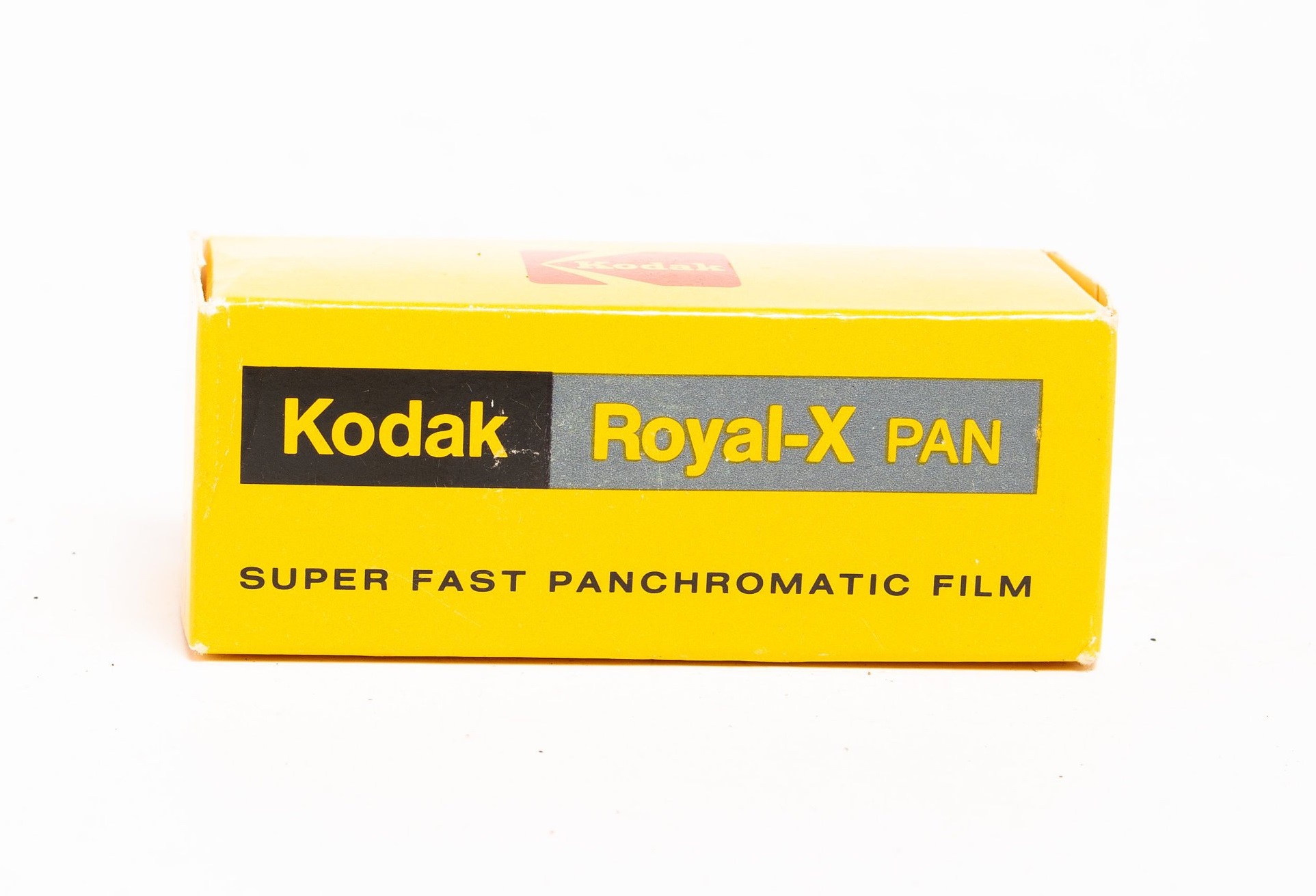
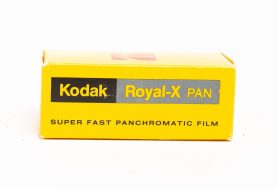
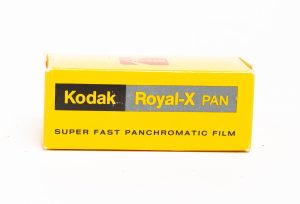
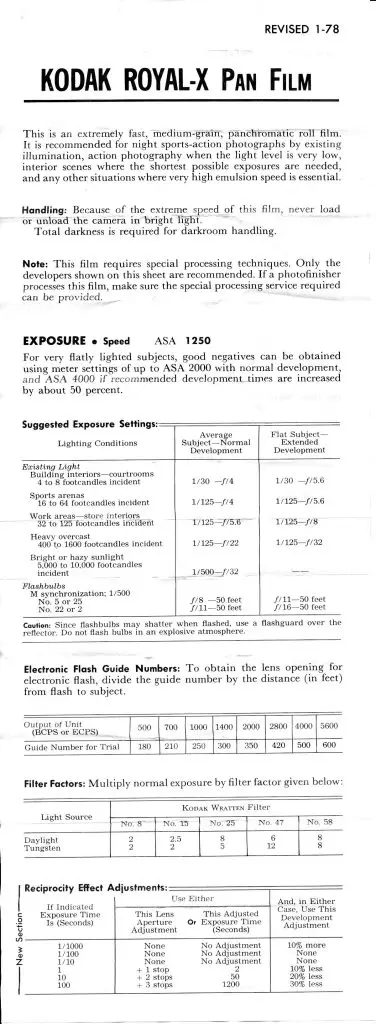
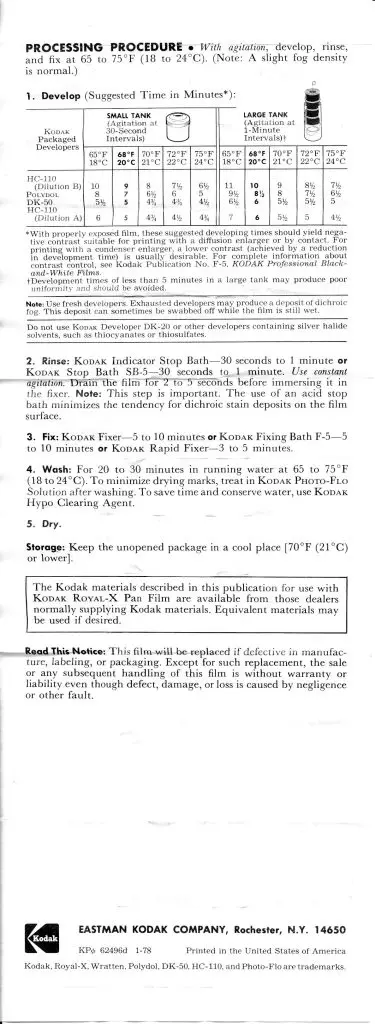
Hi, Mike. This post brought back memories. I only ever shot one 120 roll of Royal X Pan, sometime around the mid-1960’s. I don’t recall it being available in the UK in 35mm, so I was very surprised to see that it was in the US. In one way, this perhaps should not be that surprising as Kodachrome was not available in the UK in 120.
But my memory is that the film was rated at 1250 ASA in 120. I need to get out some of my 1960’s era catalogues to see if I can find the film listed. My experience at the shooting session almost turned into a nightmare. The day started out dull and I’d taken my YashicaMat with the intention of going to the local open air market during my lunch hour break from the office. But by this time, the skies had cleared and it was sunny. So now I had this super speed film with a camera only capable of an alleged 1/500 top speed. Fortunately, I always carried coloured filters in a small case attached to the camera strap, and wishing not to use resolution sapping small apertures, I attached a red filter.
After developing the film (don’t remember the developer used) I was taken aback by the density of the film base. The images, though, had a lot of contrast, as expected from the use of a red filter, and sharper than I would have anticipated.
Glad it helped dig up some old memories. In regards to the official rating. The Pop Photo article claims it was rated at 1600, but the Kodak technical data sheet from Jan 78 confirms your speed rating of 1250. So either Pop Photo got it wrong, Kodak changed the emulsion between 1957 and 1978, or both are correct! 🙂
Mike, I remember shooting the 35mm version of this film on a pro assignment in a dark and dingy rolling mill in Pittsburgh about 1968. Grainy is an understatement! Royal-X Pan has disappeared into the shadows of history: The Film Photography Project has neither resurrected it, nor discovered out-of-date 100′ stock to respool and sell. And Royal-X Pan also does not appear on any version of the Massive Development Chart: http://darkroom-solutions.com/
I also recall reading about Royal-X Pan’s official rating of ASA 1250 in the late 1960’s at college. I may have seen it “on the shelf” at a camera store, but never bought any. These were my “let’s see how far we can push-process Tri-X Pan” in the latest speed developer. I recall trying out various film developer from Acufine Inc. along with Ethol Blue, which topped out at EI 1600-2400.
Then Kodak 2476 Recording Film with it’s super-curly Estar base popped up. This was notorious as “used by the Police, FBI, CIA” to record images of suspects/agents. This “extended red sensitivity” film had “coarse beach sand-like” grain, very little shadow detail, and #1 enlarging paper contrast.
Eventually, i grew tired of “soot and whitewash” negatives and turned to ordinary developers, a 1/21 degree spot meter, and (somewhat) faster lenses. Life in the “high ASA valley” didn’t return until the appearance of T-Max films and developers. By then, I was smitten with the “I can see for miles and miles” H&W Control Film and it’s novel Phenidone developer.
Hi Mike
I found three rolls of unused Royal X Pan 35mm film in my grandfathers camera gear.
They are dated 1963
I’ve been torn about putting a roll through his camera (Agfa Ambi Sillette and a Nikkormat) for sentimental reasons.
Thank you for supplying so much research, I had no idea it was named Royal after the queens coronation.
I’m in New Zealand, but I’d be happy to send you a roll, since you have done so much background work. Just be happy to see some decent images from Pops old film
Regards
Craig
Thanks for the kind words, Craig. If you decide to shoot that film, I would strongly recommend doing some bracketing with the first roll. Faster films like Royal-X Pan do not age well, and likely will need extra exposure to look right. Personally, I would not try a mechanical camera like the Ambi Silette for that roll. Pick a more modern fully automatic metered camera which allows you to manually set ISO and shoot the entire roll bracketing exposure. I would start with ASA 50 and go up to around 1000. With the camera in full Program AE mode, and manually setting ISO, you can be sure of the exact speed of the film when you develop your images. Make sure to keep track of which images were shot with which ISO. Then when you see the developed negatives, whichever one looks the best, that’s the speed you should use for the other two rolls in whatever camera you want.
Royal-X Pan was never available in 35mm format in the UK, so we used Agfa Isopan Record instead. Both films could be rated at 3200 and still retain shadow detail.
Greatr article